A NUMERICAL INVESTIGATION OF BLOOD FLOW THROUGH THE AORTIC VALVE
Tóm tắt
This article aims to present a numerical analysis of blood flow in the aortic valve using fluid-structure interaction simulation. The finite element method is employed both for fluid and solid domains, and the monolithic scheme is used for the strong fluid-structure interaction coupling to solve well the two challenges: add-mass and large deformation problems. The Navier-Stokes equations are solved using the integrated method based on the unstructured grid on Arbitrary Lagrangian-Eulerian (ALE) framework with the total Lagrangian formulation is used for the non-linear behavior of the aortic valve. A smoothing technique based on the Laplace equation is employed to improve the mesh quality for both 2D and 3D geometries. The fluid characteristics, such as the velocity and pressure in the valve, are evaluated and analyzed in detail. The results show that velocity and pressure reach their maximum values when the valve is at its maximum opening. On the other hand, more vortices appear behind the valve during the closing phases. The simulation results can be used to help fully to predict and treat cardiovascular diseases.

